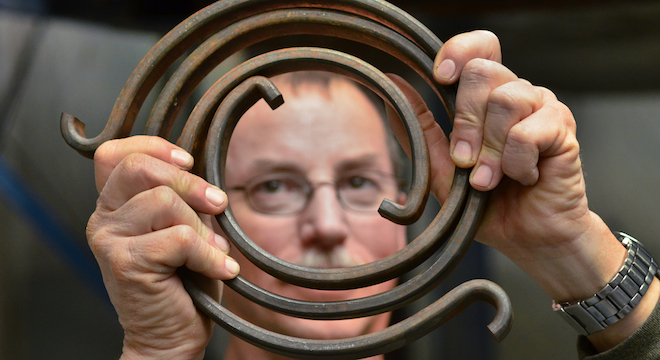TINA CASEY
The U.S. Navy has teamed up with the Department of Energy’s Sandia National Laboratory to revive decades-old technology for a high performance drill bit, only they don’t have drilling for oil or gas in mind. The drill bit, called a polycrystalline diamond compact bit, is being retested evaluated and improved to help lower the cost of drilling for geothermal energy.
The mashup of the Navy with the development of high efficiency geothermal drilling technology is a natural one, given that the Navy has been investigating geothermal energy for decades, and the Navy’s Air Weapons Station China Lake research facility in California is the site of a major geothermal power plant that has been in operation for 15 years.
As a whole, in recent years the Department of Defense has ramped up its pursuit of geothermal energy and other forms of locally generated energy such as solar power, wind and biogas in order to unchain U.S. national defense facilities from reliance on grid-supplied sources.
Ironically, Sandia originally helped to develop polycrystalline diamond compact (PDC) technology about 30 years ago specifically to help the geothermal industry cut costs. However, given the industry’s small size at the time, there were relatively few opportunities to refine the technology in practice, so the oil and gas industry picked up the ball and ran with it.
PDC technology is based on a process called sintering, which involves fabricating objects from powders. According to Sandia’s press materials:
“Polycrystalline diamond compact cutters on the cutting faces of bits allow more aggressive drilling than bits traditionally used for geothermal drilling. They are created by a sintering process. Graphite powder is applied to the leading face of a cutter made of tungsten carbide. The material assembly is compressed in three directions at pressures of 1 million pounds per square inch. When heated to a transition temperature, the graphite converts a to a 1-millimeter layer of synthetic diamond.”
Since oil and gas drilling generally takes place in sedimentary rock, which is relatively softer and cool, commercially available PDC bits still haven’t been fully tested and developed for geothermal drilling.
Geothermal drilling generally involves much more complicated conditions than found in oil and gas fields. Aside from involving higher temperatures and greater depths, geothermal drilling typically occurs in igneous and metamorphic rock, which is much harder and contains abrasive materials such as quartz. Fracturing in these formations also creates sudden changes in conditions that can damage the drill. As explained by researcher David Raymond of Sandia:
“Oil and gas drilling is normally done in softer and less-fractured rock, resulting in fewer problems with fluid circulation to remove debris and cool the bit. Oil and gas drilling also doesn’t usually involve the higher temperatures that geothermal wells exhibit.”
For the first round of tests, Sandia worked with the Navy’s contractor to drill in a section of the Chocolate Mountain Aerial Gunnery Range at the Salton Sea in California, using commercially available PDC bits.
Chocolate Mountain is an area that the Navy has been exploring for geothermal energy since the 1970’s. The drilling site is in the Camp Billy Machen/Hot Mineral Spa section, which is characterized by granite and andesite, a type of volcanic rock.
The test involved drilling down about 3,000 feet, almost 1,300 of which was accomplished with two PDC bits. At a rate of about 30 feet per hour, they performed almost three times better than standard bits.
The next phase involves data analysis and evaluation leading to improvements in the bit’s design and materials.
As the oil and gas industry exhausts the drilling potential in “easier” rock, it could also stand to benefit from further improvements in PDC technology, courtesy of the Department of Energy.
Alternative energy is also just one small example of the Navy’s long history of technological innovation leading to private sector benefits, and in that regard it is a little odd that Senator John McCain, himself a Navy man, chose to throw stones at both the Department of Energy and at the Navy’s current research into biofuels when Navy Secretary Ray Mabus testified at a Senate Armed Services Committee at a hearing last Tuesday.
Specifically, according to an account in The Hill, McCain appears ready to monkey wrench the Navy’s entire alternative energy program through amendments to the Pentagon’s 2013 budget.
So much for “drill baby, drill.”









